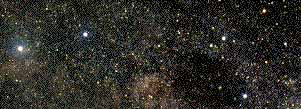Visual Magnitude
Hipparchus, in 129 BC, arranged the stars in order of brightness. He declared the brightest stars to be 1st magnitude stars and those just visible to the eye to be 6th magnitude. Hipparchus's scale accomodates all stars that can be seen with the unaided eye. The modern system of brightness classification is built on his foundation.Pogson, in 1856, measured the amount of light received from stars. He noticed that 1st magnitude stars transmitted about 100 times more light than 6th magnitude stars.
The modern brightness scale has a 2.512 fold increase in brightness between the steps. (Note: 2.512 is the fifth root of 100 - five increments by that factor results in the 100 fold change in brightness that Pogson noticed).
To allow for the inclusion of objects brighter than magnitude 1, astronomers extended the scale to zero and on into negative numbers. To include objects beyond the sensitivity of the unaided eye, astronomers extended the scale to higher positive numbers.
The sky around the Southern Cross contains stars across the full range of visual magnitudes. Move the mouse pointer across the links in the table to highlight some representative stars in the image.
Michael Gallagher
Star Data from Guide8, Project Pluto
Last updated Nov 2003
across the full range of visual magnitudes.

Move the mouse pointer over the links below to locate stars
| Object | Vis Mag | Distance |
| Sun | -26.0 | - |
| Full Moon | -12.0 | - |
| Venus | -4.0 | - |
| Jupiter | -2.0 | - |
| Sirius | -1.4 | 8.6 ly |
| Canopus | -0.6 | 314 ly |
| Alpha Centauri | -0.3 | 4.3 ly |
| Beta Centauri | 0.6 | 526 ly |
| Alpha Crucis | 0.8 | 321 ly |
| Beta Crucis | 1.2 | 353 ly |
| Gamma Crucis | 1.6 | 88 ly |
| Delta Crucis | 2.8 | 364 ly |
| Epsilon Crucis | 3.6 | 228 ly |
| Iota Crucis | 4.7 | 125 ly |
| BL Crucis | 5.5 | 566 ly |
| Proxima Centauri | 10.8 | 4.2 ly |
| faintest objects | 30.0 | - |
Proxima Centauri is the next closest star after the Sun. Its position is indicated on the image, but it is far too dim to be seen at this resolution.